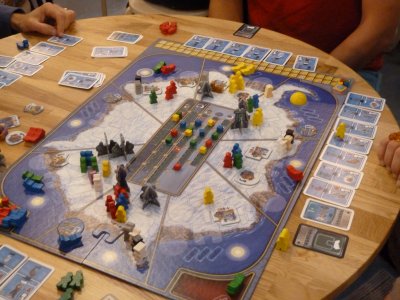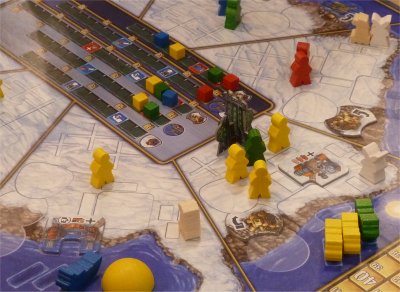

![[IMAGE]](../bilder/antarc1.jpg) |
Designer: Publisher: No. of Players: |
![[IMAGE]](../technik/box/rot/rot-6.gif) ![[IMAGE]](../technik/box/gelb/gelb-7.gif) ![[IMAGE]](../technik/box/grun/grun-6.gif) ![[IMAGE]](../technik/box/pink/pink-8.gif) ![[IMAGE]](../technik/box/blau/blau-7.gif) |
|
In 2015 ARGENTUM has returned to the SPIEL convention to present Antarctica, a game about the exploitation of the Antarctic by Charles Chevallier. If you look at the gameboard after a game of Antarctica has finished, it looks like the players have covered the South Pole with some kind of crazy industrial complex. The eight areas around the pole now are filled with cranes, derricks, laboratories, dockyards, research stations, plankton farms etc, and around these buildings scurry dozens of scientists in the players' colours. As the game's story sets out, all this industrialization was aimed at improving mankind's technological progress, and the player who has performed best in the categories of scientists per area, progress on research tracks, and placement of new buildings will have won the game.
 Building new buildings and placing scientists? This may lead you to the expectation that Antarctica might feature just another combination of resource management and worker placement mechanisms, but if you think back to my introductory notes about ARGENTUM VERLAG you shouldn't really be surprised that this expectation is quite wrong. Indeed, Antarctica is a game where good timing is a central element, and so the players need to have ships (their main playing pawns) in the right areas at the right time to take opportunities to set up new buildings. At the beginning of the game each of the eight Antarctic areas just contains one of eight starting buildings, and each player has two or three of his ships docked at different areas. Each area features a harbor which can dock up to three ships, and the order in which the ships are docked will be quite important since the game proceeds with the sun moving around the gameboard, activating the Antarctic areas in counter-clockwise order. It is always the player with his ship docked in the first docking slot of the activated are who may now take a turn. To take a turn, the active player now takes his ship and moves it to any of the other seven areas, provided the chosen area has at least one free docking slot. Once the ship has left, all other ships in the active "sun" area will move one slot forwards in docking order, whereas the active player must place his ship last in the docking order of the newly reached area. When the ship has docked at the new area, the player may perform some actions in this area, with the erection of new buildings being the most prominent action. Buildings do not depend on resources, but instead three decks of Building cards are always available to all players, with the top card of each deck being revealed and showing which building can be built. To use a Building card and place a new building, the active player needs to have ships in areas containing all buildings which are listed as prerequisites on the chosen Building card, and when this condition can be met the player takes the card and places the new building plus a number of scientists (as listed on the card) into the area. This may actually sound confusing, but in a nutshell the mechanism can be summarized as "have your ships at areas which contain certain buildings". If this condition is met, the player may chose and perform a fitting Building card. Other actions available to the player depend on the availability of certain buildings in the new area, and so the player may take new scientist meeples into his stockpile of the area contains a camp or he may advance his marker on one of the research tracks if the area contains a fitting research station. The efficiency of the action depends on the number of the player's ships and scientists present in the area, and the more ships plus scientists are present the better will be the result of the action.  If a dockyard is available in the area, the player also may opt to build a new ship, thus increasing his number of playing pawns and overall his total number of actions. However, all other players will receive a compensation of one Dock card, and these cards will allow them some special one-time effects. Special effects may also be triggered by a player marker advancing on one of the research tracks, and in general these effects are quite beneficial like an additional ship movement, the recruitment of new scientists etc. When the player has performed his action, play continues with the sun advancing one area counter-clockwise, and once again the player with his ship docking in the first docking slot will take a turn. Over the years I have seen games like The Circlewhere a wheel-like mechanism of delayed availability of playing pieces takes a central role. However, in Antarctica the whole gameboard functions like a gigantic timer, with the players having control over the player sequence through the placement of their ships. This core element of the game is finely interwoven with the rules for placement of new buildings and scientists, and taken together these elements make for an interesting challenge in which the players vie with each other to see the best open opportunities for actions. Quite interesting is also the end-game scoring which is triggered either by the erection of the last building or by a player placing his last scientist meeple on the gameboard. Every area and every research track is scored separately, and the player with most scientists (area) or most research progress (research track) always will score a number of victory points equal to sum of scorings reached by all players in this area/research track. This gives the leader a considerable advantage in comparison to a normal majority scoring, and players need to get used to this scoring variant since it may result in harder battles for certain areas. With these elements keeping the player's minds, Charles Chevallier rightly has decided on limiting the number of available Building cards in order to keep the game from getting too complex. As a result, the players are confronted with a manageable amount of available actions, and so they can focus quite well on the game's core mechanisms. To my mind Antarctica blends in quite well with ARGENTUM's portfolio of strategically challenging boardgames. The unusual combination of player order and actions gives the game a solid tactical emphasis, and together with other unusual games like Ginkgopolis it can stand its ground as a building game with a certain twist! | ||
|
| ||

|
|

|
|
| ||
|
Impressum / Contact Info / Disclaimer Kulkmann@aol.com
Copyright & copy; 2015 Frank Schulte-Kulkmann, Essen, Germany | ||